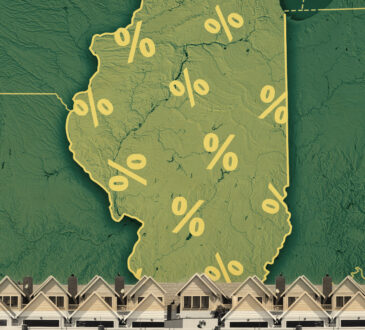
Here’s a closer look at changes to individual property type expectations for the coming year:
Office
How we got here
Remote working has disrupted demand for office spaces across the industry. Despite the addition of over two million in-office jobs in the United States alone since 2020, the sector still shed nearly 200 million square feet of occupied space,10 and, on average, has experienced nearly 10% in asset value declines11 over the same period. Further gripped by greater economic uncertainty through early 2023, occupiers of commercial space have exhibited caution in new lease signings. This has driven vacancies upward across the globe, topping 15.6%, led by quarterly increases in North America (+53 bps) and Asia/Pacific (+42 bps) followed by Europe (+10 bps).12 As a result, office property valuations slipped down by 4.5% globally, topped by North America (5.9%) and followed by Asia/Pacific (3.4%) and Europe (2.0%).13
However, all things have not been equal across the real estate sector. Newer, high-quality assets continue to significantly outperform the rest as the flight to quality accelerates.14 Estimates suggest that new construction designed to accommodate hybrid work strategies has absorbed more than 100 million square feet of unused space. And while many regions still struggle with price discovery due to falling investment activity, the value gap between better-quality and lower-quality assets has clearly widened.15
A new foundation
Through early 2023, we may have gained more clarity on what realistic, stabilizing office space utilization rates across the globe might look like. On average, US office space utilization has steadied at just under 50% of prepandemic levels, compared to 70% to 90% in Europe and 80% to 110% in Asia/Pacific.16 Global variations can be attributed to varied housing formats, commute times, and labor markets.17
Real estate office owners and investors should acknowledge that hybrid work is here to stay. It is shifting how offices are used and valued, so valuation strategies should change as well. Now almost three years into assessing pandemic-era space requirements, office occupiers have more insight into how much office space they may need. According to CBRE’s most recent office occupier survey, 60% of US respondents believe their office utilization has stabilized, up from 43% who expected to reach a steady state in 2022.18 Those who still expect further utilization increases are primarily from firms with the lowest current utilization rates, and 71% of respondents expect their companies to reach steady state by the first half of 2024.
The office sector should be rebalanced, similar to what regional malls faced several years ago.19 Real estate services firm Cushman & Wakefield estimates that nearly 60% of existing US office inventory needs reinvestment or to be upgraded, with another 20% being completely undesirable without major work.20 At this stage, office owners and investors should be realistic about what to do with underperforming assets. They could consider adaptive reuse, conversion to meet higher-quality demand or sustainability regulations, or, if conversion wouldn’t be cost-effective, outright demolition. As we discussed in Deloitte’s 2023 FSI Predictions, should market fundamentals further deteriorate for the office sector, coupled with sustained stability in the multifamily sector, office-to-residential conversion opportunities could become a broadly viable option by 2027.21
Retail
How we got here
Following a near-historic retreat in consumer sentiment in early 2023, retail conditions are trending upward recently. In the United States, July marked the second consecutive month consumer sentiment rose, as efforts to tame inflation have so far been successful.22 Deloitte’s State of the Consumer Tracker shows consumers globally have consistently improved their finances; only 35% of respondents feel their financial position worsened over the past year through late June, down from 41% in February.23
Retail tenant demand has maintained momentum due to several years of industry transformation and larger retailer consolidations in higher-quality locations, despite varying degrees of health from economic indicators. According to Coresight Research, US store openings outpaced store closings by over 1,500 stores in 2022, and just under 1,000 stores so far through 2023.24 Leasing activity has generally remained positive across North America, Europe, and Asia/Pacific.25
A new foundation
Despite several prominent retailers filing for bankruptcy over the past year, there is still healthy demand, and landlords remain optimistic they can still quickly fill vacancies and push rents higher.26 This resiliency speaks not only to the retailers themselves—those who survived a pandemic and have generally built more robust operations with stronger financials—but also to the state of retail development and the favorable balance of supply and demand.27 While other sectors have gone through supply-side booms over the past few years, new retail development is still structurally restrained due to limited new constructions and demolitions from widespread store closures during the late 2010s.
E-commerce should be a tailwind for growth. Six in 10 retail executives foresee strengthening digital commerce offerings as a top opportunity,28 but the pace of growth has normalized from highs during the heights of the pandemic. Upgrading physical locations with better digital capabilities can help retailers achieve greater success. Retailers that can continue to build more robust efficiencies across last-mile distribution capabilities, omnichannel logistics, and e-commerce presence could define the next era of tenants. Landlords should be keen to lure these retailers into their locations.29
Industrial
How we got here
Boosted by growing e-commerce and third-party logistics providers, along with investments in reshoring initiatives to bolster stretched supply chains and domestic manufacturing, sustained demand for industrial locations has still led to high competition for existing space. Spending on consumer goods during the pandemic pushed demand for warehousing and manufacturing space to new heights. Absorption doubled in 2021 compared to the 2015–2019 average and exceeded that prior average by over 60% in 2022.30 To help meet this demand, a record amount of new construction is scheduled to begin by the end of 2023. But some markets are still supply-constrained and have near sub-1% vacancies. As a result, rent growth continues: 18.6% in North America, 10.8% in Europe, and 6.4% in Asia/Pacific year-over-year in mid-2023.31
A new foundation
A record industrial construction pipeline aims to address the vast supply/demand imbalance. Regulatory incentives are helping, too. Notable incentives are energy credits and tax deductions from the Inflation Reduction Act and the Creating Helpful Incentives to Produce Semiconductors Act (CHIPS Act). Other actions to better balance supply with demand include transitioning to new transportation and energy technologies and nearshoring global supply chains for more responsive operations.32 But this construction boom could face two potential threats: first, a lack of available land to build, particularly “megasites,” 1,000+ acre plots of land that have transit access near a skilled labor pool; and second, a robust-enough energy infrastructure to support these facilities.33
Megasites are custom-designed to meet the needs of a single occupier. These often have expedited development timelines, especially where time-sensitive tax incentives are in play. Megasite users have come to expect shovel-ready sites, but in the United States, fewer than two dozen sites like these are left.34 Land options become even more scarce for factories needing access to substantial sources of electricity, such as chip manufacturers and electric vehicle battery plants. Finding the right mix of conditions in breaking ground for new megasites could become more difficult. As a result, developers have faced costly extensions to project timelines for much-needed inventory. This, too, has contributed to higher rents.35
Residential
How we got here
On the heels of interest rate hikes, home sales reversed from the pandemic-era boom and pockets of home pricing corrections have emerged. Yet, despite these price drops, inflated mortgage costs and accessibility to capital have kept buyer activity muted.36 As a result, the outsized demand for multifamily rental properties that started during the pandemic continues. Most US markets have seen rent growth top 20% since 2019.37
Accounting for regional variances in common mortgage structures, household incomes, and central bank policies, a recent report categorized the progress of developed housing markets across the globe into three segments: early adjusters, bullet dodgers, and slow movers.38 Canada and Australia fell into the early adjuster camp; in these countries, buyers leveraged more accessible variable-rate mortgage terms during the pandemic, when credit was cheaper. Since then, they have experienced some of the steepest pricing corrections to date. The United States and France have seemingly dodged a few bullets: Most US homeowners hold long-term fixed-rate mortgages following the housing crisis in 2008. And among homeowners in France, there is very little household debt.39 These two markets have not seen significant, widespread price deflation so far through 2023 compared to other global regions. The United Kingdom and Germany are still in much earlier stages of housing volatility. Pricing is only starting to turn, but developers are beginning to worry as housing purchase demand wanes.40
A new foundation
Affordability will likely continue to be a fundamental issue that impacts global housing markets, especially among renters and first-time homebuyers. How municipal and federal governments respond could be pivotal in addressing housing supply and demand. Enacting policies that allow for more favorable zoning, such as allowing for more units to be constructed on a single lot, as well as financial incentives like low interest loans or tax abatements, could help.41 But so far, inflexibility at local levels has prevented measures like this from being adopted more broadly.42
The supply of new, affordable inventories will likely still be limited across many parts of the world due to inflated construction costs and difficulties obtaining development financing. US housing construction is expected to bounce back, but not until 2025, when forecasts suggest it could reach around 1.5 million units delivered per year.43 With the mismatch in global supply and demand for home purchases, multifamily rentals could still serve an accessible outlet for housing for those priced out of the market.44 As consumers continue to live in rental units waiting for their chance to buy, demand for multifamily rental properties could continue to be strong.
Hotel
How we got here
Vaccine rollouts and easing travel restrictions have helped the hotel industry steadily rebound. Benefiting from pent-up lack of leisure travel, the average revenue per available room exceeded prepandemic levels in the Americas (+14%) and Europe (+13%) but is still behind in Asia/Pacific (-7%).45
Hotel operators are increasingly concerned about “the quality equation”: balancing top-of-the-line service offerings while they face continued staffing shortages and supply chain limitations.46 At the end of 2022, the hospitality labor force was only 84% of prepandemic levels, and rising materials costs and limited financing options have delayed needed renovations and limited owners’ and operators’ abilities to invest in upgrades.47 This, combined with the increased cost of service, could have travelers questioning the value they received for their money.
A new foundation
The demand for hotel space is on the brink of a full global recovery, but with the reemergence of leisure travel comes a greater expectation per dollar spent. The days where travelers gave operators a pass on the price-versus-experience equation due to the pandemic, inflation, or labor shortages are likely over.48 As travelers become increasingly price-sensitive amid financial instability, hotel operators should meet their customer’s experience expectations head-on or they could risk losing them.
Corporate travel still lags behind as part of the recovery. While leisure travelers outnumbered business travelers, the latter historically contributes much more to bottom lines.49 If, by the end of 2024, companies recover to 2019 business travel spending levels, when adjusting for inflation, corporate travel could likely settle about 10% to 20% lower than it was prior to the pandemic.50 The United States and Europe are on similar recovery trajectories: In both markets, corporate travel spending is expected to reach only two-thirds of prepandemic levels by the end of 2023. A full recovery to 2019 corporate travel spending is not expected in the United States and Europe until late 2024 or early 2025.51
Alternatives: Digital economy, specialty housing, and life sciences
Digital economy
Hyperscale tenants, those that manage large-scale computing resources, dominated digital economy property demand again in 2022. Since then, they’ve started to expand into secondary and emerging markets. But in more developed regions, they may face limited land availability and power cost increases, limiting expansion opportunities. The sector has been at the mercy of utility price volatility, brought on by geopolitical instability in Europe, with median electricity costs increasing 16% last year.52 As the network of data center properties expands further to meet the growing needs of the digital landscape, fiber density and quality, as well as cloud availability, could be key drivers in locating new facilities.53
Single-family rentals/build-to-rent
Rent growth for existing single-family rentals has slowed. Eroding affordability is leaving fewer funds available for renters to meet more cost increases. Though rent growth has flattened out of late, rather than declined, it could be more likely that the 26% rent growth since the onset of the pandemic has likely become the new baseline.54 BTR home construction, on the other hand, is still thriving. Developers targeting this space are taking advantage of demand for those looking for private homes but want to wait for the dust to settle before committing to buying.55 In Europe, investors seeking further housing diversification outside of traditional multifamily have turned to these niche rental housing sectors. The United Kingdom has been the primary target; capital topped US$3.5 billion by June 2023, placing it second globally behind the United States.56
Senior housing
The perpetual demand due to an aging populace should sustain the senior living sector. Older populations around the globe are growing in number and proportion at a faster pace than historically. Between 2015 and 2050, the share of global populations 60 years and older is expected to nearly double, from 12% to 22%. By 2030, one in six people will be aged 60 or older.57 Revenue opportunities for the sector are expected to grow more than 6.5% over the next five years, but could end up lower because of increased operating costs and staffing shortages.58 In the long run, senior housing margins could benefit from adding more inventory and more diverse product offerings, such as active adult communities or ultra-luxury retirement facilities.
Life sciences
The exponential growth trajectory for the life sciences sector realized during the height of the pandemic has leveled off so far into 2023, though demand for space is still outpacing prepandemic levels.59 More recent economic headwinds, particularly in the banking sector, have paused some venture capital funding of life science companies, although levels still remain well above prepandemic funding by about 15%.60 Vacancies are expected to increase as record new construction comes online to meet demand, but should still remain well under long-term average vacancies, further propping up rental growth. The continued confidence in the underlying demand for medicines should drive optimism for life science users over the next several months,61 even though capital inflows from public and private sources could be tested again if volatility hits financial markets.




